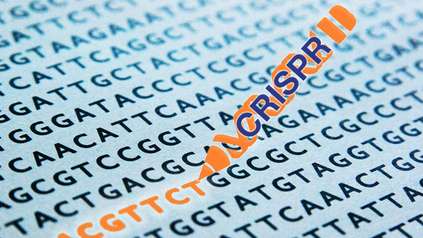Drug screens and CRISPR combine to help make better cancer drugs
A new study has created the most comprehensive analysis for understanding how cancer drugs work at a molecular level. Scientists at the Wellcome Sanger Institute, EMBL’s European Bioinformatics Institute (EMBL-EBI) and AstraZeneca combined drug response data with CRISPR genetic screens across hundreds of cancer cell lines to better understand precisely how drugs target cancer cells.
The research, published in Molecular Systems Biology, identified the mechanism-of-action in 50 per cent of the 397 drugs tested. This improved understanding of the biological mechanisms underpinning drug response will facilitate faster, more efficient development of new cancer drugs and brings us closer to precision medicine for cancer patients.
Historically, the success rate of drug development has been low, with fewer than 10 per cent of prospective compounds proceeding to clinical trials*.
The exact mechanism by which a drug kills cancer cells – its mechanism-of-action – may not be fully understood at a molecular level, meaning it may not work as expected. This is particularly problematic when a drug is designed to target specific weaknesses in cancer cells due to genetic changes in their DNA. Some drugs target multiple proteins and tend to be more toxic for patients. Others are not potent enough and are therefore not effective at killing the cancer.
But in recent years, several new methods have helped to improve the success rate of drug candidates. Initiatives such as the Cancer Dependency Map (Cancer DepMap) have created reference collections of cancer cell models** from patient tumours that can be grown in the laboratory and used widely in research. One use of these cell models is for pharmacological screens, which test the activity of anti-cancer drugs to identify how sensitive particular cancers are to particular compounds.
Another major breakthrough has been the development of CRISPR-Cas9 technology to edit the genes in cancer cells lines, turning them off one-by-one to measure how critical they are for the cancer to survive.
In this new study, researchers for the first time combined CRISPR-Cas9 screens with pharmacological screens for 397 unique anti-cancer compounds across 484 cancer cell lines. Compounds included FDA-approved cancer drugs, drugs in clinical development, and compounds in early development.
The team investigated the extent to which drug sensitivity corresponded to CRISPR knock-out of drug targets by searching for associations between the two datasets across the 484 cell lines. They identified 865 significant associations between drug response and gene dependency.
“The effect of knocking out a gene and the effect of inhibiting a protein that the gene produces aren’t necessarily the same thing. But when a molecular pathway or function is associated with both drug response data and CRISPR screen data, it gives us a much clearer idea of how a drug is working at the molecular level, and the ability to detect when a drug is not working as we expect.”
Dr Emanuel Gonçalves, first author of the study from the Wellcome Sanger Institute
The team were able to identify how the drug killed cancer cells in up to 50 per cent of the compounds tested. Although the mechanism-of-action could not be identified for around half of the drugs tested, this does not mean that those compounds are not useful. It may be that more knowledge is required to fully understand how they work on a molecular level.
The study also turned up some surprising results, such as an association between the MCL1 and MARCH5 genes in breast cancer cell lines. MCL1 is commonly altered in human cancers and is associated with resistance to chemotherapy and relapse. In breast cancer cell lines that depended on both MARCH5 and MCL1, drugs designed to target the MCL1 protein to inhibit its activity were much more effective.
“Fully understanding the molecular pathways involved is the key to understanding why a drug may work on one patient’s cancer but not on another’s. The association between MARCH5 and MCL1 in breast cancer, for example, suggests an important molecular relationship that we were unaware of. This in turn helps us to understand the mechanism-of-action of MCL1 protein inhibitors and in which cancer cases these drugs will be effective.”
Dr Aldo Segura-Cabrera, of EMBL’s European Bioinformatics Institute (EMBL-EBI)
This fuller understanding of the biological mechanisms underpinning drug response, and the genomic context in which they happen, will help researchers to identify new biomarkers, guide drug combination therapies and combat resistance to cancer drugs.
“A key challenge in precision medicine is understanding what drugs are most effective in specific patients. A critical step is to truly understand how a drug is working in cells and this can be surprisingly difficult. By combining pharmacological and CRISPR screens on this scale, it gives us unparalleled insights into how drugs are working and in what cancer types. This work brings us a step closer to precision cancer medicine.”
Dr Mathew Garnett, senior author of the paper from the Wellcome Sanger Institute
More information
* Dowden, H. & Munro, J. (2019). Trends in clinical success rates and therapeutic focus. Nat Reviews Drug Discovery 18, 495-496, DOI: 10.1038/d41573-019-00074-z
** Cell lines can be created for different types of tumour at different stages of their progression, including post-treatment. This allows researchers to recreate the conditions of a patient’s cancer so they can better assess what treatments will be effective.
Publication:
Emanuel Gonçalves, Aldo Segura-Cabrera and Clare Pacini et al. (2020). Drug mechanism-of-action discovery through the integration of pharmacological and CRISPR screens. Molecular Systems Biology. DOI: https://doi.org/10.15252/msb.20199405
Funding:
This research was funded by Wellcome (206194) and AstraZeneca.
Selected websites
EMBL’s European Bioinformatics Institute (EMBL-EBI)
EMBL’s European Bioinformatics Institute (EMBL-EBI) is a global leader in the storage, analysis and dissemination of large biological datasets. EMBL-EBI helps scientists realise the potential of ‘big data’ by enhancing their ability to exploit complex information to make discoveries that benefit humankind.
EMBL-EBI is at the forefront of computational biology research, with work spanning sequence analysis methods, multi-dimensional statistical analysis and data-driven biological discovery, from plant biology to mammalian development and disease.
EMBL-EBI is part of the European Molecular Biology Laboratory (EMBL), an international, innovative and interdisciplinary research organisation funded by 25 member states and two associate member states, and are located on the Wellcome Genome Campus, one of the world’s largest concentrations of scientific and technical expertise in genomics. www.ebi.ac.uk
About the Cancer Dependency Map
The consequences of alterations in the DNA of cancer cells and subsequent vulnerabilities are not fully understood. This project aims to assign a dependency to every cancer cell in a patient which could be exploited to develop new therapies.
Further details about the different laboratories and projects at the Sanger Institute contributing to the Cancer Dependency Map can be found at our Dependency Map website.
The Wellcome Sanger Institute
The Wellcome Sanger Institute is a world leading genomics research centre. We undertake large-scale research that forms the foundations of knowledge in biology and medicine. We are open and collaborative; our data, results, tools and technologies are shared across the globe to advance science. Our ambition is vast – we take on projects that are not possible anywhere else. We use the power of genome sequencing to understand and harness the information in DNA. Funded by Wellcome, we have the freedom and support to push the boundaries of genomics. Our findings are used to improve health and to understand life on Earth. Find out more at www.sanger.ac.uk or follow us on Twitter, Facebook, LinkedIn and on our Blog.
About Wellcome
Wellcome exists to improve health by helping great ideas to thrive. We support researchers, we take on big health challenges, we campaign for better science, and we help everyone get involved with science and health research. We are a politically and financially independent foundation. https://wellcome.org/




